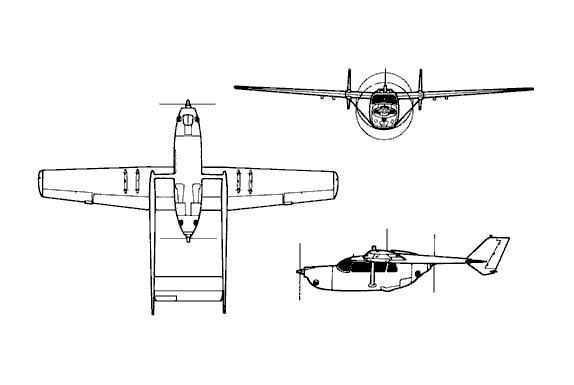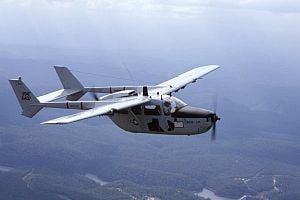Top speed 322 km/h Wingspan 12 m Unit cost 92,000–92,000 USD First flight January 1967 | Range 2,132 km Length 9.07 m | |
 | ||
Cessna o 2 skymaster flying display at sanicole airshow 2015
The Cessna O-2 Skymaster (nicknamed "Oscar Deuce") is a military version of the Cessna 337 Super Skymaster, used for forward air control (FAC) and psychological operations (PSYOPS) by the US military between 1967 and 2010.
Contents
- Cessna o 2 skymaster flying display at sanicole airshow 2015
- Cessna o 2 skymaster
- Design and development
- US Air Force
- US Navy
- US Army
- South Vietnam
- El Salvador
- CAL FIRE
- Variants
- Operators
- Specifications O 2
- Aircraft on display
- References

In 1966 the United States Air Force (USAF) commissioned Cessna to build a military variant to replace the O-1 Bird Dog and the O-2 resulted.

Cessna o 2 skymaster
Design and development

As with the civilian version, the Skymaster was a low-cost twin-engine piston-powered aircraft, with one engine in the nose of the aircraft and a second engine in the rear of the fuselage. The push-pull configuration meant a simpler single-engine operating procedure due to centerline thrust compared to the common low-wing mounting of most twin engine light planes, and also allowed for a high wing, providing clear observation below and behind the aircraft.

Modifications made for the military configuration included installation of single seating fore and aft (i.e. two tandem seats available for pilot and observer, vs. 6 seats available in the civilian version); installation of view panels in the doors (for improved ground observation); installation of flame-retardant foam in the wing-mounted fuel tanks (slight increase in empty vehicle weight; 3% reduction in available fuel capacity); installation of military communication and navigation equipment in lieu of available civilian equipment and antennas; deletion of propeller spinners; increased gross weight (5,400 lb vs. 4,400 lb in civilian version), with component strengthening as required to support the increase; and deletion of interior upholstery.

The first O-2 flew in January 1967 and the plane went into production shortly thereafter. Performance (especially at cruising altitudes) was degraded due to the added antennas and significant weight increase, but was considered sufficient for the anticipated low-level operation.
U.S. Air Force

The USAF took delivery of the O-2 Skymaster in March 1967 and the O-2A also entered the U.S. Army's inventory during 1967, from USAF stock. By 1970, a total of 532 O-2s had been built, in two variants, for the USAF.
During the Vietnam War, the O-2A was introduced as a replacement for the O-1 Bird Dog, in the forward air control (FAC) aircraft and served in that role with the 20th Tactical Air Support Squadron. The O-2B was equipped with loudspeakers and a leaflet dispenser for use in the psychological operations (PSYOPS) role.
While it was intended that the Skymaster be replaced in the FAC mission by the OV-10 Bronco, the O-2A continued to be used for night missions after the OV-10's introduction, due to the OV-10's high level of cockpit illumination, rendering night reconnaissance impractical. The O-2 was phased out completely after additional night upgrades to the OV-10.
A total of 178 USAF O-2 Skymasters were lost in the Vietnam War, to all causes.
Following the Vietnam War, the O-2 continued to operate with both U.S. Air Force and Air National Guard units into the late 1980s.
U.S. Navy
Six former USAF O-2A airframes were transferred to the U.S. Navy in 1983 for use as range controllers with Attack Squadron 122 (VA-122), the Pacific Fleet Replacement Squadron for the A-7 Corsair II at Naval Air Station Lemoore, California. These aircraft were later transferred to Strike Fighter Squadron 125 (VFA-125), the F/A-18 Hornet FRS at NAS Lemoore, in 1986 for use in the same range control role. These O-2A aircraft were eventually replaced by T-34C Turbomentor aircraft transferred from the Naval Air Training Command.
U.S. Army
Of the six USN aircraft mentioned above, two were transferred to the U.S. Army in late 1990. USAF O-2As were augmented by the 1990 aircraft transfer from the Navy. Several disassembled USAF O-2s remain in storage at Davis-Monthan AFB, Arizona. Two O-2As were used at Laguna Army Airfield, Arizona as part of testing programs carried out by the Yuma Proving Ground. These were retired in October 2010 and sent to a museum.
South Vietnam
Several USAF O-2 aircraft were later transferred to and operated by the former VNAF South Vietnamese Air Force.
El Salvador
During the Salvadoran Civil War, the Salvadoran Air Force received a total of 23 O-2As and 2 O-2Bs from the United States, the first arriving in 1981. They were employed to observe the movements of FMLN formations and direct air strikes against them, playing a major role in forcing the rebel movement to abandon large-scale operations.
Near the end of the war in 1990, the rebels' acquisition of SA-7 missiles resulted in the loss of two O-2As, while another was destroyed by mortar fire, and two more were lost in crashes.
CAL FIRE
In the mid 1970s, the California Department of Forestry and Fire Protection, or CAL FIRE, found that the contractor-owned air attack aircraft, mostly single-engine Cessna 182s and Cessna 210s, did not provide the airspeed and safety needed for the department's new air tanker program. In 1974, Senior Air Operations Officer Cotton Mason inspected 40 USAF O-2s at Davis-Monthan Air Force Base. The best 20 were selected and shipped to Fresno, California. These aircraft had been FAC aircraft in Vietnam and were shipped back to the United States in containers, and were disassembled and on pallets when they arrived at Fresno. A crew of California Conservation Corps (CCC) members under the supervision of a CDF Battalion Chief, who was an FAA Certificated Mechanic with Inspection Authorization (IA), reassembled the aircraft.
They were placed in service in 1976, and served CAL FIRE for more than 20 years, until replaced by a fleet of OV-10 Broncos.
Variants
Operators
Specifications (O-2)
General characteristics
Performance
Armament
